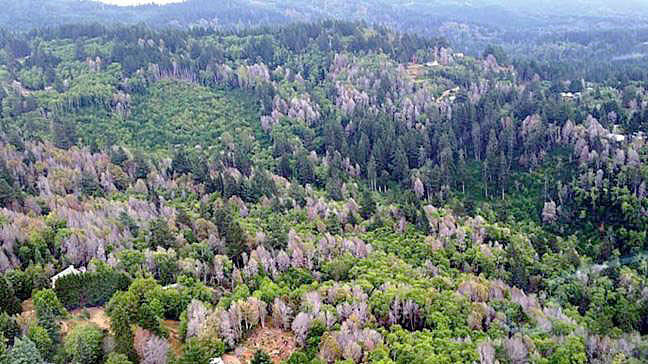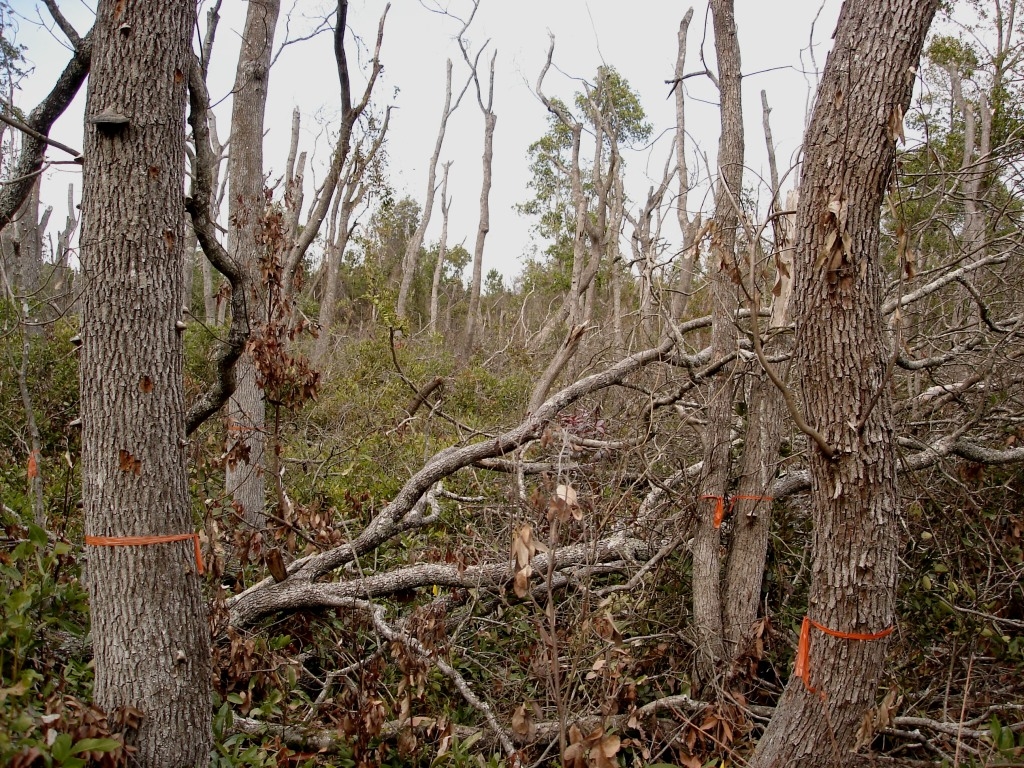
photo courtesy of Oregon Department of Forestry
Stunning 2019 Nursery Outbreak – Continuing Story
I have blogged often about the sudden oak death pathogen Phytophthora ramorum. The most recent blogs have focused on last year’s episode in which infected plants were sent to retail nurseries in many states. Indeed, the 2019 outbreak led to the largest trace-forward investigation for the USDA APHIS’ Phytophthora ramorum program in a single year for more than a decade. A year later, much is still unclear. For example, based on reports last year, I told you that 18 states had received positive plants. APHIS now says it was 14.
In response to states’ requests, APHIS issued a “Hotwash Report” (described in the June 2020 newsletter of the California Oak Mortality Task Force (COMTF); see source list at the end of the blog for the url). The “Hotwash Report” says APHIS traced the infected plants back to two nurseries, but I have obtained information about efforts at only one – in Washington state – and even that information is not as explicit as I think should be. In the April COMTF newsletter, the Washington State Department of Agriculture reports only that compliance surveys at one wholesale shipping nursery would be more intense than usual. I believe the second nursery implicated in the event is in British Columbia, but the Canadian Food Inspection Agency has said it saw no evidence that a Canadian nursery had shipped infected plants to the U.S.
Indiana officials reported (Press et al.) that the infected plants received in that state were of the NA2 clonal lineage. This is the first report of the NA2 lineage outside British Columbia, Washington, and California and is thus especially significant. The outbreak caused Indiana authorities to ordered destruction of more than 6,100 rhododendron plants at retail outlets in Indiana. (April COMTF newsletter)
According to the June 2020 COMTF newsletter, APHIS revised its Phytophthora ramorum Domestic Regulatory Program Manual (available here). APHIS also reviewed the protocol governing responses to detection of P. ramorum in retail nurseries (available here). The agency also plans to carry out a full program review but no timeline has been announced.
It is not clear to me whether these actions satisfy the states or – most importantly – address the reasons why such a large breakout of nursery infestations escaped current regulatory safeguards.
APHIS Slow Walks a Revised Host List
Meanwhile, carrying out a promise made in May 2019 when APHIS revised the SOD regulations, APHIS has posted a revised list of officially recognized P. ramorum hosts (available here). Finally! The new list replaces one from 2013.
The new list recognizes only one new species (Gaultheria procumbens, eastern teaberry) as a proven host, based on completion of Koch’s postulates. (The scientific paper was published five years ago!) So far, APHIS would only recognize a host after Koch’s postulates were completed. But the agency has been unwilling to pay for the experimental work required.
That situation might be changing: APHIS says it is reviewing scientific publications and ongoing research. The agency also invites scientists to contact the national program manager regarding plant taxa that they believe should be added to the regulated plant taxa list.
Meanwhile, we know that scientists have completed Koch’s postulates on several new hosts: Brisbane box, Lophostemon confertus, taken from samples of street trees dying in central Sausalito, Marin Co., California (COMTF June newsletter); and seven species of Arctostaphylos (manzanita) (COMTF April newsletter). So far, there’s no word from APHIS as to if or when it might act on these.
Nursery Situation in Individual States
California
Inspections under various federal and state regulatory requirements have detected infected plants in five nurseries (COMTF June newsletter). Two are in counties with widespread infestations that ship only within the state. Infected plants were Camellia and Loropetalum (COMTF April newsletter). Three other nurseries, also that ship within the state, tested positive only in previous years. Trace investigations completed at four of these nurseries by June had detected no additional positive plants. (COMTF June newsletter)
Oregon
Western Oregon has a climate that favors P. ramorum. One result is intensification and spread of the forest infestation (see below); another is a perpetual problem with infected nurseries.
In fall 2019, Oregon Department of Agriculture detected positive plants and soil at an interstate shipper. The plants were destroyed. Trace-back detected no further positive detections. The areas with infested soil were taped off until authorities can carry out steaming to decontaminate (COMTF April newsletter).
Meanwhile, trace-back from a previously identified retail location led to a second commercial interstate shipper. Camellia, Pieris, and Rhododendron plants tested positive, along with three soil samples and one groundwater sample. This was the first detection for this wholesale location (COMTF April newsletter).
Then, a routine inspection detected P. ramorum at a third interstate shipper in early March 2020. As of April, seven Rhododendron plants tested positive. This was also the first detection at this particular nursery (COMTF April newsletter).
Meanwhile, the spring compliance surveys at 10 Oregon nurseries that ship interstate found no P. ramorum (COMTF October newsletter).
In August, Oregon Department of Agriculture conducted soil steaming at three nurseries that previously tested positive. The action was successful at two but not at the third due to irrigation issues. APHIS and ODA are working with the nursery to create an enhanced mitigation plan focusing on irrigation at the nursery (COMTF October newsletter).
However, trouble continues. In July, a North Carolina nursery reported positive Rhododendron plants that had been purchased from an Oregon nursery. Traceback detected infected Rhododendron plants at the site. Further tracebacks have been triggered at the locations where this material was purchased – apparently yet another nursery. The nursery is undergoing the final assessment to sign a federal compliance agreement and will be added to the list of nurseries sampled by ODA in fall (COMTF October newsletter).
Washington
Washington officials continue to detect P. ramorum in water bodies that have proved difficult to trace back to a plant source. Positive water samples were collected again from the pond at the botanic garden in Kitsap County – as has been true for most years since 2015. Despite the continuing presence of the pathogen in the pond, authorities have not been able to find infected plants in recent years, including in 2020.
Authorities also detected a water-positive at a nursery participating in the P. ramorum compliance program. They have scheduled additional vegetation and water sampling (COMTF April newsletter). It is not stated whether this is the nursery apparently responsible for the 2019 spread event.
A third positive water sample was collected on a creek in Snohomish County. The state Department of Agriculture plans to follow up with two nurseries in the drainage. One had previously tested positive (COMTF April newsletter).
In June, the state conducted a trace-forward investigation on plants from a positive out-of-state nursery. Most plants had been sold at the retail level and were untraceable. However, 37 Rhododendron planted in several residential locations were sampled; six plants at four sites were positive. The Confirmed Residential Protocol has been enacted at all four locations (COMTF August 2020). Authorities also treated the soil at two of the planting sites (COMTF October newsletter).
The Risk of New Phytophthora Introductions Is Dire
The COMTF June newsletter summarizes the findings of studies by European forest pathologists. As I reported in an earlier blog, European researcher have identified more than100 previously unknown Phytophthora species through intensive surveys conducted during 2013 – 2019 in natural ecosystems of Japan, Taiwan, Vietnam, Indonesia, Chile, Nicaragua, Panama, Curacao, Egypt and eight European countries. Overall, 13,242 isolates were obtained, which could be assigned to 65 known and 101 previously unknown species. Two of the most damaging – P. cinnamomi and P. ramorum – are most likely native to Southeast Asia. The scientists recommend extensive host-range testing of forest tree and horticultural crop species to assess the potential threat posed by the import of living plants from Southeast Asia. Several presentations and factsheets with further information may be found here. https://www.ponteproject.eu/
Early in the year, I attempted to persuade APHIS to begin studies of possible hosts’ vulnerability, but I was told that APHIS does not do research. I also approached the Agriculture Research Service and USDA Forest Service. Perhaps academic scientist could obtain funding to carry out such studies through grants funded by the Plant Pest and Disease Management and Disaster Prevention Programs (under Section 7721 of the Plant Protection Act) or National Institute of Food and Agriculture.
Wildland Infestations – Threat to native plants; interactions with fire
The COMTF April 2020 newsletter reports the growing threat to manzanitas from P. ramorum. The genus Arctostaphylos includes more than 100 species of evergreen shrubs and small trees. Nearly half are classified as rare, threatened, or endangered. The center of diversity is in the San Francisco area – which overlaps with the area intensely infested by P. ramorum. At least 18 manzanita species support the pathogen. Koch’s postulates have been completed on seven of the most recently detected hosts, and are under way for two others. I am grateful to the California Department of Food and Agriculture for carrying out these studies; without them, APHIS would not recognize the plants’ host status. (Despite requiring completion of Koch’s postulates, APHIS does not fund these studies.)
A study of the interaction between P. ramorum and fire in California (October COMTF newsletter and Simler-Williamson et al.) found that frequently-burned forests were less likely to be invaded by the pathogen, had lower incidence of host infection, and lower occurrence and density of epidemiologically-significant hosts. The authors think that the fire-caused loss of tall, mature California bay laurel trees might temporarily dampen pathogen transmission and “release” susceptible species from significant inoculum pressure.
The June COMTF newsletter reports that the forest infestation in Oregon continues to spread. During spring 2020, Oregon detected 15 new P. ramorum infestations at or beyond the Oregon Generally Infested Area (GIA). The October newsletter reports that 38 stream drainages both inside and outside the SOD quarantine area were baited, and one at the northern boundary of the quarantine area was positive for P. ramorum. The Oregon Department of Forestry installed additional stream baits in the drainage to pinpoint the infestation, and plans a stream survey for the area. Planned eradication efforts have been impeded by funding cuts caused by Covid-19-related falls in tax receipts.
Posted by Faith Campbell
We welcome comments that supplement or correct factual information, suggest new approaches, or promote thoughtful consideration. We post comments that disagree with us — but not those we judge to be not civil or inflammatory.
For a detailed discussion of the policies and practices that have allowed these pests to enter and spread – and that do not promote effective restoration strategies – review the Fading Forests report at http://treeimprovement.utk.edu/FadingForests.htm
SOURCES
California Oak Mortality Task Force (COMTF newsletters) – archive of 2020 newsletters at https://www.suddenoakdeath.org/library/newsletter-archive/
Press, C.; Fieland, V.; Creswell, T.; Bonkowski, J.; Miles, L. and Grünwald, N.J. 2020 (First Look). First report of the NA2 clonal lineage of Phytophthora ramorum in Indiana. Plant Disease. https://doi.org/10.1094/PDIS-12-19-2543-PDN.
Simler-Williamson, A.B.; Metz, M.R.; Frangioso, K.M. and Rizzo, D.M. 2020. Wildfire alters the disturbance impacts of an emerging forest disease via changes to host occurrence and demographic structure. Journal of Ecology. Early View. https://doi.org/10.1111/1365-2745.13495

